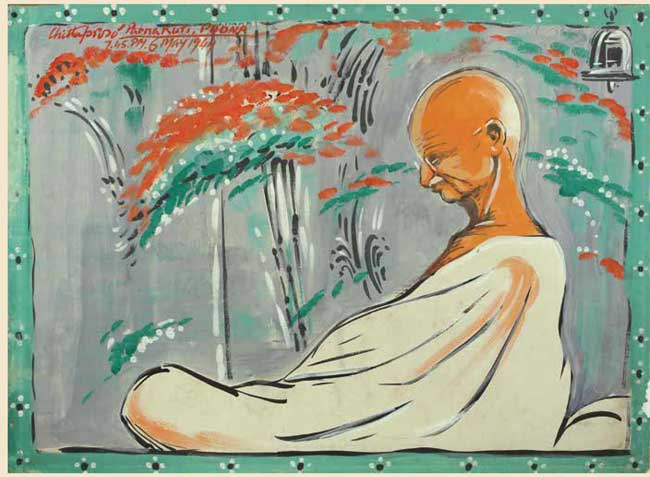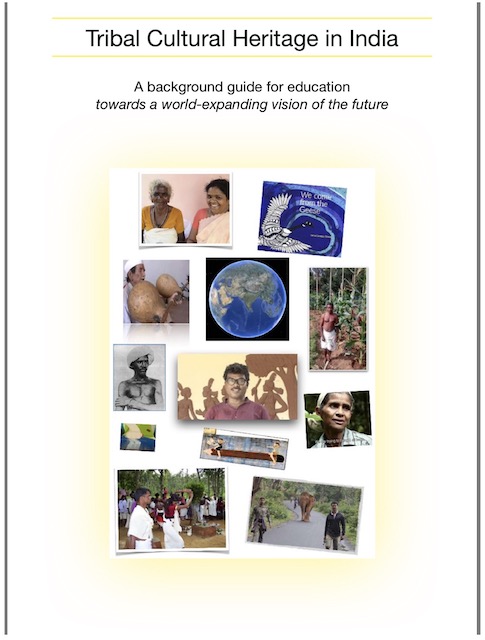Gond tribal painting is an integral part of tribal festivities, rituals, and day-to-day living
When one lives amidst nature, one’s life is the life of nature, one’s thoughts are the thoughts of the birds, deer and the rivers and one’s expressions are full of nature’s form and gestures.
The exhibition of Gond tribal paintings from June 5 to 15 [2009], at the Kerala Lalit Kala Akademi, Thrissur, was a portrayal of a life and culture so much in sync with nature that it cannot be expressed without it. The Gonds are tribals hailing from Madhya Pradesh. Their paintings are indeed the reflection of a culture where life and spirituality were integrated with the forest and its creatures.
Originally done witfour-coloured mud found in the forest, the Gond tribal paintings were drawn on the walls of the houses and were an integral part of the tribal festivity, rituals, and day-to-day living.
Gond tribal women would go to the forest to collect these colours. “We used to go in groups and it would take us the whole day to collect the mud and return to the village,” said Nankushiya, a tribal woman painter participating in the workshop.
Gonds believe that Narmada was once a woman and was married to the Sonmura river. […]
Now the painters have started drawing on canvas with acrylic. […]
Today, Gonds are fast catching up with city life, and modern-day amenities, but most of their rituals remain the same. As Japani said, “Thoughts have changed and so also the lifestyle. Houses are fast changing into concrete ones. However, the tradition of painting on the walls is still there.” The young artist further made a point, “We exhibit our paintings at many places around the country. People often tell us to take up modern art but we want to stick to our tribal painting style and the depiction of our culture and nature through it. We also would like to give our perspective of the outside world through our art.” […]
Today Japani’s and Nankushiya’s paintings depicting the Gond life with its festivity, forests and traditions are displayed in many of our urban living rooms, reminding us of the many things we have lost in the process of gaining affluence. […]
Source: Rituals – Where art imitates life by Venus Vinod Upadhayaya lifepositive.com
Address : http://www.lifepositive.com/Spirit/Rituals/Where_art_imitates_life82009.asp
Date Visited: Sun Aug 28 2011 17:25:30 GMT+0200 (CEST)
“We shall first have to give up this hubris of considering tribes backward. Every tribe has a rich and living cultural tradition and we must respect them.” – Vice President M. Venkaiah Naidu on the constitutional obligation to respect the cultural traditions of India’s tribal communities

Gandhian social movement | Constitution | Adverse inclusion >>
“Air is free to all but if it is polluted it harms our health… Next comes water… From now on we must take up the effort to secure water. Councillors are servants of the people and we have a right to question them.” – Mohandas K. Gandhi, Ahmedabad address on 1 January 1918; quoted by his grandson, Gopalkrishna Gandhi, in “On another New Year’s Day: Mahatma Gandhi’s ‘khorak’ a 100 years ago” (The Hindu, 1 January 2018)
“The world has enough for everyone’s need but not for anyone’s greed.” – Mahatma Gandhi quoted by Medha Patkar and Baba Amte (Narmada Bachao Andolan)

Learn more about Baba Amte and the Narmada valley on Safe search >>
See also
Forest Rights Act (FRA) | Legal rights over forest land
Health and nutrition | Recommendations by the Expert Committee
People’s Archive of Rural India (PARI) | RuralIndiaOnline.org
States along the Narmada river’s course (source to Arabian Sea):
Madhya Pradesh | Maharashtra | Gujarat
Tips for using interactive maps
Toggle to normal view (from reader view) should the interactive map not be displayed by your tablet, smartphone or pc browser
For details and hyperlinks click on the rectangular button (left on the map’s header)
Scroll and click on one of the markers for information of special interest
Explore India’s tribal cultural heritage with the help of another interactive map >>
